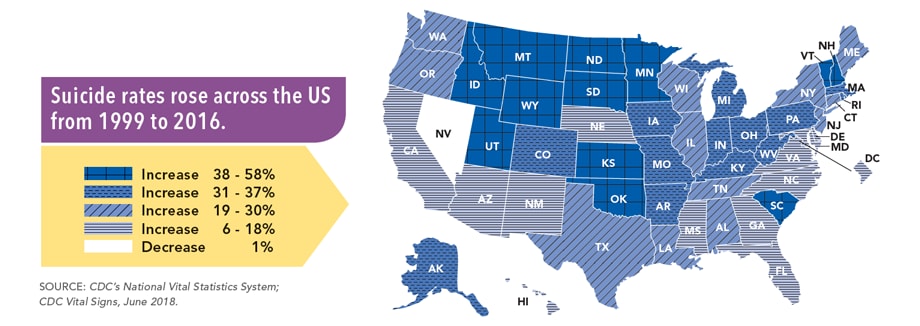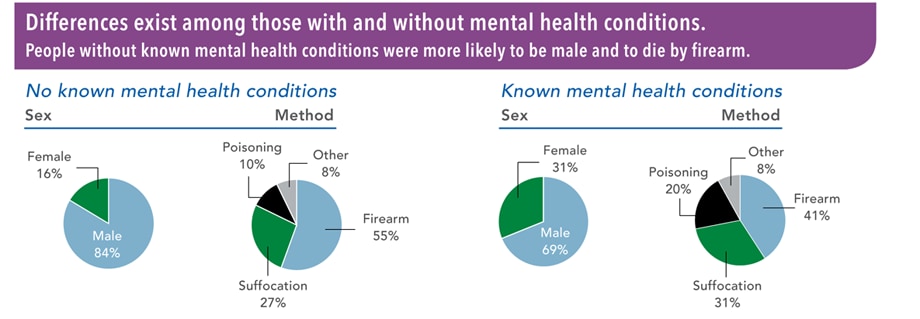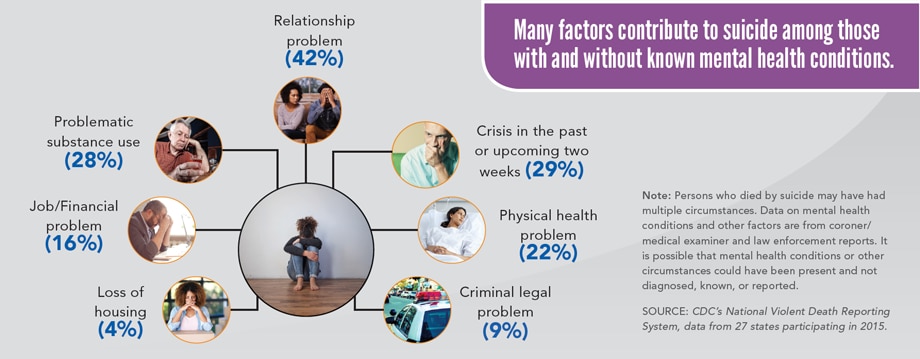Who’s working on this problem?
Suicide rates are higher in Rural Areas2
Suicide rates in nonmetropolitan/rural counties are consistently higher than suicide rates in metropolitan counties. These trends also are observed by sex, race/ethnicity, age group, and mechanism of death.
Suicide rates increased across the three urbanization levels, with higher rates in nonmetropolitan/rural counties than in medium/small or large metropolitan counties. Each urbanization level experienced substantial annual rate changes at different times during the study period. Across urbanization levels, suicide rates were consistently highest for men and non-Hispanic American Indian/Alaska Natives compared with rates for women and other racial/ethnic groups; however, rates were highest for non-Hispanic whites in more metropolitan counties. Trends indicate that suicide rates for non-Hispanic blacks were lowest in nonmetropolitan/rural counties and highest in more urban counties. Increases in suicide rates occurred for all age groups across urbanization levels, with the highest rates for persons aged 35–64 years. For the mechanism of death, higher increases in rates of suicide by firearms and hanging/suffocation occurred across all urbanization levels; rates of suicide by firearms in nonmetropolitan/rural counties were almost two times that of rates in larger metropolitan counties.
Are certain groups of people at higher risk than others3 ?
According to the Centers for Disease Control and Prevention (CDC), men are more likely to die by suicide than women, but women are more likely to attempt suicide. Men are more likely to use more lethal methods, such as firearms or suffocation. Women are more likely than men to attempt suicide by poisoning.
Also per the CDC, certain demographic subgroups are at higher risk. For example, American Indian and Alaska Native youth and middle-aged persons have the highest rate of suicide, followed by non-Hispanic White middle-aged and older adult males. African Americans have the lowest suicide rate, while Hispanics have the second-lowest rate. The exception to this is younger children. African American children under the age of 12 have a higher rate of suicide than White children. While younger preteens and teens have a lower rate of suicide than older adolescents, there has been a significant rise in the suicide rate among youth ages 10 to 14. Suicide ranks as the second leading cause of death for this age group, accounting for 425 deaths per year and surpassing the death rate for traffic accidents, which is the most common cause of death for young people.

States and communities can:
- Identify and support people at risk of suicide.
- Teach coping and problem-solving skills to help people manage challenges with their relationships, jobs, health, or other concerns.
- Promote safe and supportive environments. This includes safely storing medications and firearms to reduce access among people at risk.
- Offer activities that bring people together, so they feel connected and not alone.
- Connect people at risk to effective and coordinated mental and physical healthcare.
- Expand options for temporary help for those struggling to make ends meet.
- Prevent future risk of suicide among those who have lost a loved one to suicide.
The Problem
Suicide rates increased in almost every state1 .
 View large image and text description
View large image and text description
 View large image and text description
View large image and text description
 View large image and text description
View large image and text description
Know the 12 Suicide WARNING SIGNS
- Feeling like a burden
- Being isolated
- Increased anxiety
- Feeling trapped or in unbearable pain
- Increased substance use
- Looking for a way to access lethal means
- Increased anger or rage
- Extreme mood swings
- Expressing hopelessness
- Sleeping too little or too much
- Talking or posting about wanting to die
- Making plans for suicide

5 Steps to help someone at risk
- Ask.
- Keep them safe.
- Be there.
- Help them connect.
- Follow up.
WHAT CAN WE DO TO PREVENT SUICIDE?
Preventing suicide involves everyone in the community.
Provide financial support to individuals in need.
- States can help ease unemployment and housing stress by providing temporary support.
Strengthen access to and delivery of care.
- Healthcare systems can offer treatment options by phone or online, where services are not widely available.
Create protective environments.
- Employers can apply policies that create a healthy environment and reduce stigma about seeking help.
Connect people within their communities.
- Communities can offer programs and events to increase a sense of belonging among residents.
Teach coping and problem-solving skills.
- Schools can teach students skills to manage challenges like relationships and school problems.
Prevent future risks.
- Media can describe helping resources and avoid headlines or details that increase risk.
Identify and support people at risk.
- Everyone can learn the signs of suicide, how to respond, and where to access help.
Jay Harold hopes you enjoyed this post, “This post “Relationship Problems #1 cause of Suicide: Learn 6 More” seeks to provide helpful information about this disease.” please share it and read more about Jay Harold here. Please take this advice from Muhammad Ali and give back to others. “Service to others is the rent you pay for your room here on earth.”




